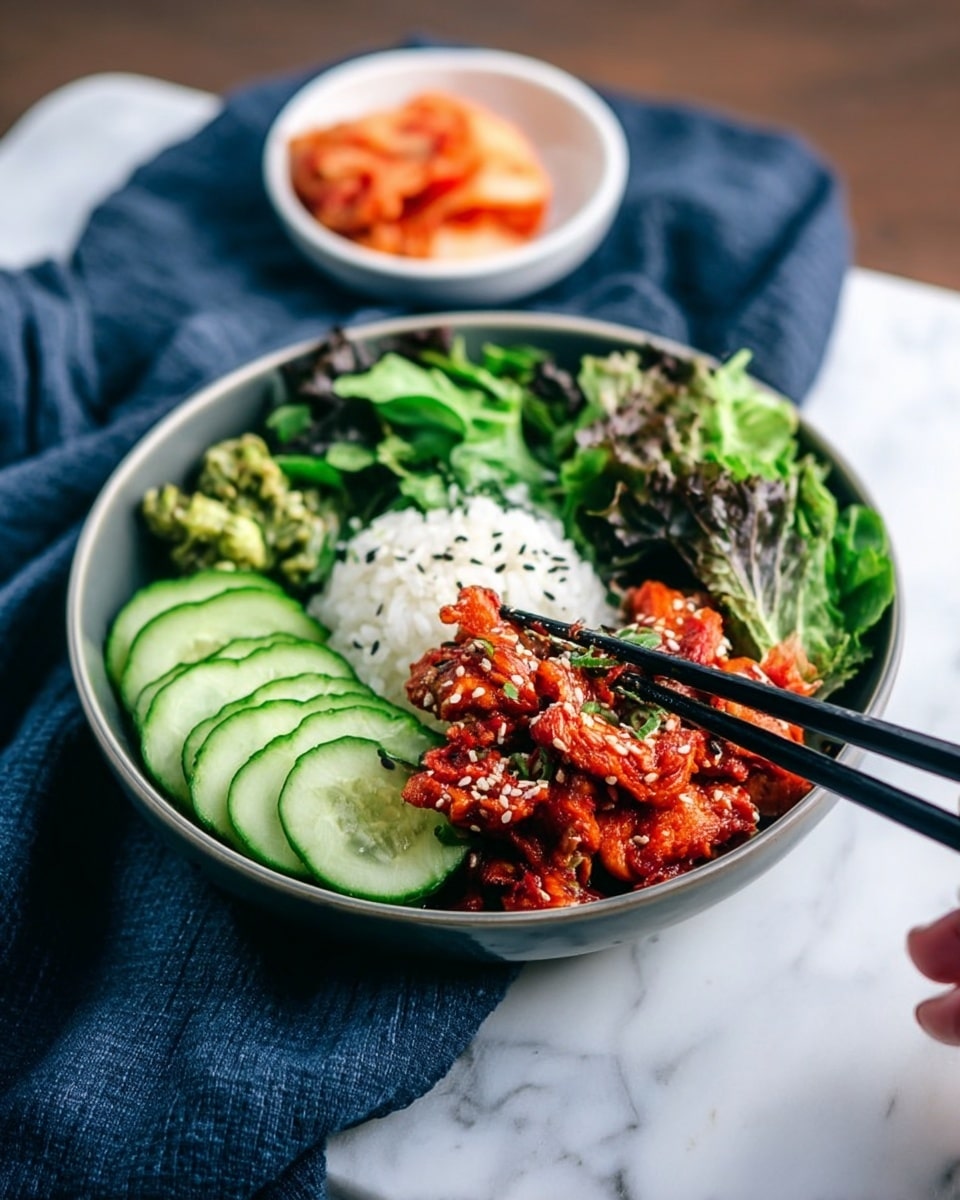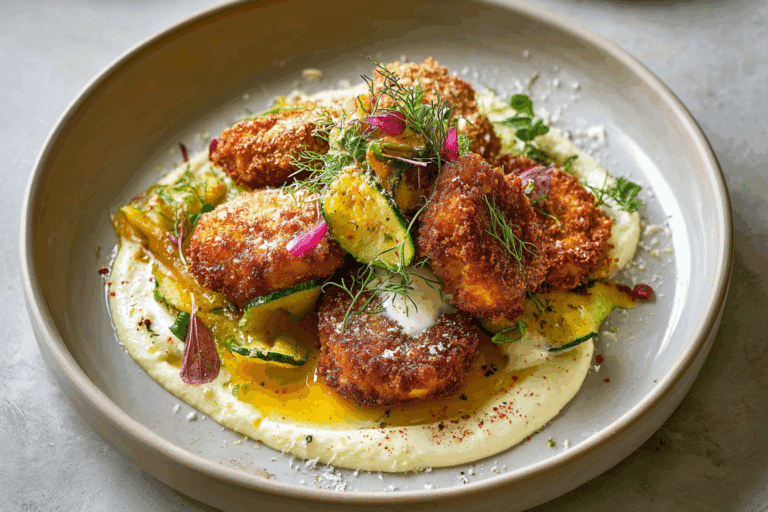Spicy Pork Bulgogi Rice Bowl Recipe
If you’re craving a meal that bursts with bold flavors and comforting textures, this Spicy Pork Bulgogi Rice Bowl Recipe is absolutely the answer. I’ve made it time and again because it hits that sweet spot of spicy, savory, and just a little bit tangy—all wrapped up in tender pork and fresh veggies over steaming rice. It’s one of those dishes that’s quick enough for a weeknight but special enough to impress company.
What makes this Spicy Pork Bulgogi Rice Bowl Recipe worth trying is the marinade: a beautiful blend of Korean chili paste and flakes, honey’s mellow sweetness, and grated apple for natural tenderizing and a subtle fruity lift. When your kitchen smells like this marinade simmering, you know dinner’s going to be fabulous. Trust me, once you make it, you’ll want to keep this recipe handy.
Ingredients You’ll Need
Every ingredient in this recipe is chosen to create layers of flavor and texture that complement each other perfectly. When shopping, I always opt for fresh pork shoulder or collar butt, and never skip on the Korean staples like gochujang and gochugaru, which give this dish its signature kick.
- Pork shoulder (pork collar butt): This cut is wonderfully marbled and tender, perfect for quick stir-fries like bulgogi.
- Medium onion: Julienned to add sweetness and crunch that balances the spicy pork.
- Cooking oil (rice bran oil recommended): A neutral oil with a high smoke point, great for stir-frying without overpowering flavors.
- Green onion: Adds fresh, mild sharpness and vibrant color at the end.
- Toasted sesame seeds: A finishing touch that brings a nutty aroma and extra texture.
- Red apple (or nashi pear): Blended into the marinade, it tenderizes the pork and offers a slight sweetness.
- Brown onion: Adds depth and natural juice to the marinade base.
- Gochujang (Korean chili paste): The heart of the spicy flavor, balancing heat with umami and sweetness.
- Soy sauce: Adds savory saltiness and richness to the marinade.
- Honey (or brown sugar): Balances out heat with subtle sweetness—honey gives a nice floral note.
- Gochugaru (Korean chili flakes): For that signature mild heat and vibrant color.
- Rice wine (mirin): Adds a slightly sweet acidity to brighten up the marinade.
- Minced garlic: For punchy aroma and depth.
- Minced ginger: Brings fresh zing that cuts through the richness.
- Ground black pepper: A subtle background spice to round it off.
- Steamed rice: The perfect canvas to soak up all those spicy, flavorful juices.
- English cucumber, lettuce, Korean perilla leaves: Fresh crunchy greens that cool down the heat and add a herbal twist.
- Korean spicy dipping sauce and kimchi: Classic accompaniments that bring extra layers of complexity and tradition.
Variations
One of my favorite things about the Spicy Pork Bulgogi Rice Bowl Recipe is how flexible it is. I often tweak the spice levels or swap in different veggies depending on what I have around, making it a real weeknight winner you can personalize to your taste.
- Mild version: I dial down the gochugaru and gochujang if I’m cooking for kids or guests who prefer less heat. Adding a bit more honey balances the flavors perfectly.
- Vegetable boost: Adding sliced carrots or bell peppers is a great way to sneak more veggies in without losing that signature bulgogi flavor.
- Low-carb option: Serve the spicy pork on a bed of cauliflower rice or wrapped in lettuce cups for a fresh, lighter take.
- Extra smoky: Sometimes I toss the pork briefly on a grill pan after stir-frying to add a delicious smoky char that’s hard to beat.
How to Make Spicy Pork Bulgogi Rice Bowl Recipe
Step 1: Blend Your Marinade to Perfection
I start by popping the apple, brown onion, gochujang, soy sauce, honey, gochugaru, rice wine, garlic, ginger, and black pepper into my handheld blender or food processor. Blending these until smooth is crucial because you want every piece of pork evenly coated. The fruit helps tenderize the meat, so don’t rush this step!
Step 2: Marinate the Pork
Once your marinade is ready, toss the pork pieces in a bowl and pour over the marinade. I like to let it sit for at least 30 minutes—if you have the time, a couple of hours in the fridge makes the pork incredibly tender and flavorful. Just remember to keep it covered!
Step 3: Stir-Fry with Onions
Heat a tablespoon or two of your cooking oil (rice bran oil works great here) in a large pan over medium-high heat. Add the marinated pork along with the julienned onions, stirring frequently. You want the pork to brown nicely without burning the marinade—about 7 to 10 minutes until the pork is cooked through and caramelized in spots.
Step 4: Finish with Green Onions and Sesame Seeds
Just before you take off the heat, sprinkle in the chopped green onions and toasted sesame seeds. These give a fresh crunch and that irresistible nutty aroma that really brings the dish home.
How to Serve Spicy Pork Bulgogi Rice Bowl Recipe

Garnishes
I always garnish with thinly sliced English cucumber and a mix of fresh lettuce and Korean perilla leaves. The cool crunch balances the spicy pork perfectly and adds those lovely herbal notes that Korean cuisine is famous for. Toasted sesame seeds on top add a little extra flair and texture, too.
Side Dishes
Kimchi is an absolute must in my book—it adds that extra fermentation punch and crunchy heat that pairs perfectly. Sometimes I serve this rice bowl alongside a simple Korean spicy dipping sauce or a side of pickled radishes for acidity. It rounds out the meal beautifully!
Creative Ways to Present
For special occasions, I like to plate this in shallow bowls layered with rice at the bottom, then arrange the pork and veggies artfully on top. Drizzling a little extra gochujang sauce or a little sesame oil over everything before serving makes it look as good as it tastes. If you’re sharing with friends, a DIY rice bowl bar with all the garnishes out is always a hit.
Make Ahead and Storage
Storing Leftovers
I usually store any leftover cooked pork and onions in an airtight container in the fridge for up to 3 days. Keeping the veggies and rice separate helps maintain freshness so nothing gets soggy overnight.
Freezing
This Spicy Pork Bulgogi Rice Bowl Recipe freezes surprisingly well! After cooking and cooling, I portion out the pork (without rice or fresh garnishes) into freezer-safe bags. It keeps for about 2 months, making it a great make-ahead meal if you want to prep in advance.
Reheating
To reheat, I thaw overnight in the fridge and warm gently in a pan over medium heat, adding a splash of water or soy sauce if it’s gotten a bit dry. Reheat rice separately in the microwave or steamed so it stays fluffy and doesn’t clump up. Adding fresh garnishes after reheating really freshens things up.
FAQs
-
Can I use other cuts of pork for this Spicy Pork Bulgogi Rice Bowl Recipe?
Absolutely! While pork shoulder or collar butt works best for its tenderness and fat content, you can also try pork belly or leaner cuts like pork loin. Just be careful with cooking times—leaner cuts cook faster and can dry out, so keep an eye on them.
-
How spicy is this Spicy Pork Bulgogi Rice Bowl Recipe?
The level of spice depends a lot on the gochujang and gochugaru amounts. This recipe offers a moderate heat level that’s flavorful but not overwhelming, but you can always adjust those ingredients to suit your preference—from mild to fiery hot.
-
Can I prepare the marinade ahead of time?
Yes! You can blend the marinade a day in advance and store it in the fridge. Just give it a good stir before marinating the pork. This saves time and deepens the flavors as the ingredients meld together.
-
What should I serve with this Spicy Pork Bulgogi Rice Bowl Recipe?
I like to serve it with kimchi and a simple Korean spicy dipping sauce. Fresh sliced cucumbers and leafy greens as garnishes make it a balanced and refreshing meal.
-
Can this recipe be made gluten-free?
Yes! Use gluten-free soy sauce (tamari) and double-check that your gochujang and gochugaru don’t contain any wheat. Everything else in the recipe is naturally gluten-free.
Final Thoughts
This Spicy Pork Bulgogi Rice Bowl Recipe holds a special place in my kitchen, not just because it’s packed with incredible flavor, but because it brings people together so effortlessly. It’s one of those meals where every bite feels comforting and exciting at once, and the best part? You can tailor it completely to your tastes. I promise, once you give it a try, it’ll become a staple in your home too. So grab those ingredients and make this your next delicious adventure!
PrintSpicy Pork Bulgogi Rice Bowl Recipe
This Spicy Pork Bulgogi Rice Bowl features tender pork shoulder marinated in a flavorful blend of Korean spices, gochujang, and sweet apple, stir-fried to perfection, and served over steamed rice with fresh vegetables and kimchi. This Korean-inspired dish balances spicy, sweet, and savory flavors, making it a vibrant and satisfying meal perfect for lunch or dinner.
- Prep Time: 20 minutes
- Cook Time: 15 minutes
- Total Time: 35 minutes
- Yield: 4 servings
- Category: Main Dish
- Method: Frying
- Cuisine: Korean
Ingredients
Main Ingredients
- 600 g pork shoulder (pork collar butt), cut into small pieces for stir frying
- 170 g medium onion, julienned
- Some cooking oil (rice bran oil recommended)
- 30 g green onion, chopped
- 1 Tbsp toasted sesame seeds
Marinade
- 100 g red apple (e.g., Royal Gala) or nashi pear
- 50 g brown onion
- 3 Tbsp gochujang (Korean chili paste)
- 3 Tbsp soy sauce
- 3 Tbsp honey or brown sugar
- 2 Tbsp gochugaru (Korean chili flakes)
- 2 Tbsp rice wine (mirin)
- 1 Tbsp minced garlic
- 1 Tbsp minced ginger
- 1/8 tsp ground black pepper
Rice Bowl Serving Suggestions
- Steamed rice (for 4 people)
- 1 English cucumber, thinly sliced
- 10 leaves lettuce, thinly sliced
- 10 leaves Korean perilla, thinly sliced
- 4 tsp Korean spicy dipping sauce (about 1 tsp per person)
- Kimchi
Instructions
- Prepare the Marinade: Place the red apple or nashi pear, brown onion, gochujang, soy sauce, honey or brown sugar, gochugaru, rice wine (mirin), minced garlic, minced ginger, and ground black pepper in a handheld mixer or food processor. Blend until smooth to create a flavorful marinade.
- Marinate the Pork: Combine the small pieces of pork shoulder with the prepared marinade. Make sure the pork is evenly coated. Allow it to marinate for at least 30 minutes to an hour to absorb the flavors thoroughly.
- Prep Vegetables: Julienne the medium onion, chop the green onion, and thinly slice the English cucumber, lettuce leaves, and Korean perilla leaves. Set aside for serving.
- Cook the Pork: Heat some cooking oil (such as rice bran oil) in a large skillet or pan over medium-high heat. Add the marinated pork and stir-fry until fully cooked and caramelized, about 8 to 10 minutes. Add the julienned onions during the last few minutes of cooking to soften them.
- Assemble the Rice Bowls: Scoop steamed rice into four bowls. Top each bowl with the cooked spicy pork bulgogi, sliced cucumbers, lettuce, Korean perilla, and a sprinkle of chopped green onion and toasted sesame seeds.
- Serve with Accompaniments: Serve each bowl alongside kimchi and a teaspoon of Korean spicy dipping sauce per person for added heat and flavor.
Notes
- For best texture and flavor, use pork shoulder (also known as pork collar butt) as it has enough fat to keep the meat tender.
- If you don’t have a food processor, finely grate the apple and onion and mix the marinade ingredients thoroughly by hand.
- Adjust the level of spiciness by varying the amount of gochujang and gochugaru.
- Rice bran oil is ideal for stir frying due to its high smoke point, but you can substitute with vegetable oil.
- Allow the marinade to soak into the pork for at least 30 minutes; a few hours or overnight will deepen the flavor.
- This dish pairs well with steamed white rice or brown rice for a healthier option.








